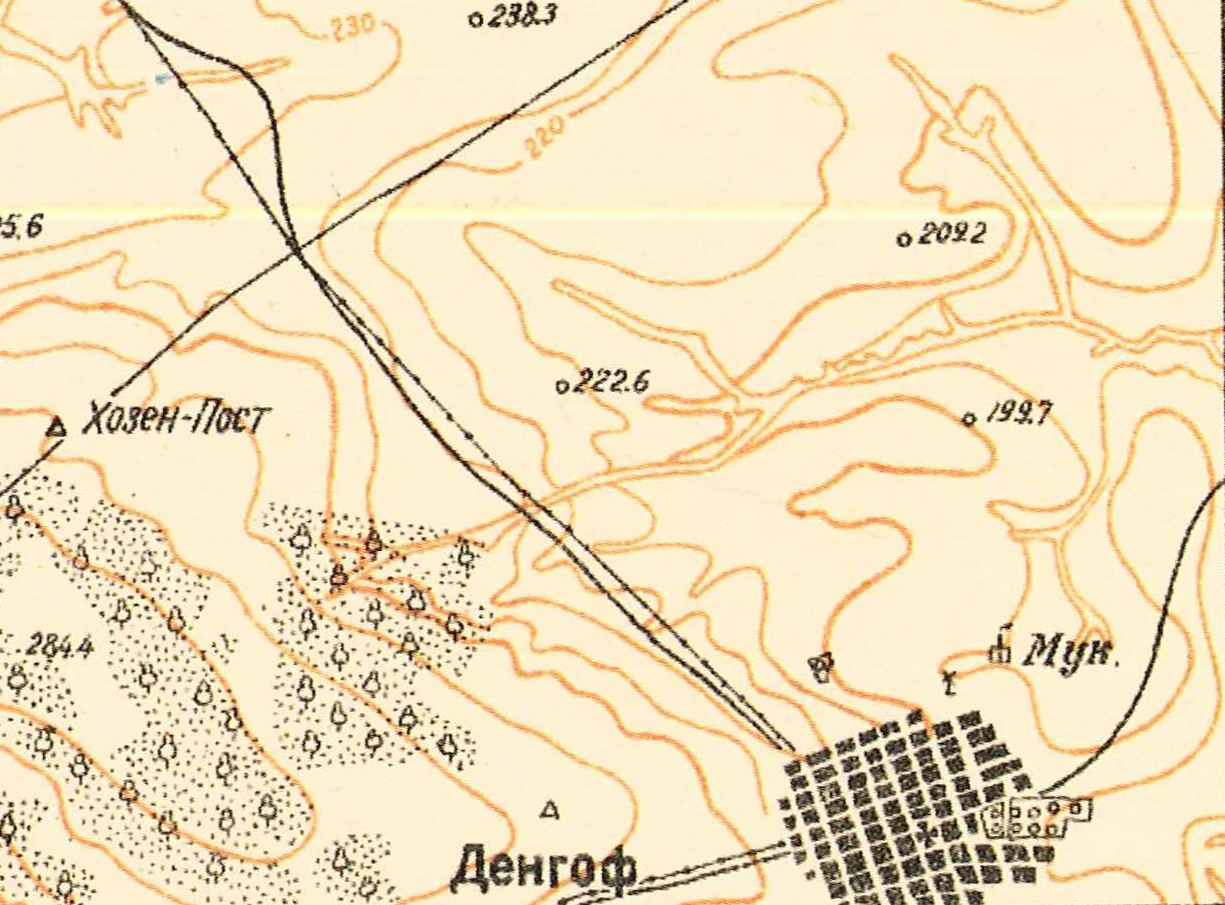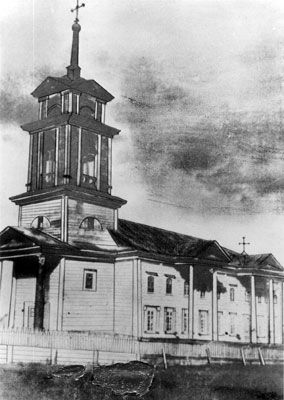Dönhof was originally part of the Grimm parish. Later it became an independent parish with a resident pastor of its own who served Dönhof and surrounding communities.
A wooden church with an iron roof was built there in 1834.
Dönhof was founded on 21 July 1766 by the Government as a Lutheran colony with settlers from Württemberg and Schleswig-Holstein (Denmark). The colony was named after the leader of that original group of settlers. By the decree of 26 February 1768, Dönhof received its official Russian name of Golobovka. The colony was attacked and plundered by Pugachev and his rebels on 11 August 1774.
From 1863 to 1887, 1,519 colonists (815 male & 704 female) resettled to daughter colonies on the Wiesenseite and in the Caucasus with some moving to America.
There was a school located in Dönhof since the founding of the colony. A college was also built there.
As of 1894, there were over 700 people engaged in the manufacture of gingham fabric. Each Monday there is a bazaar and during the summer (June 2-24) and the first Sunday in October (for 3 days), the colony held a regional trading fair.
In the 1850s, many Dönhof families resettled to the daughter colonies of Rosenberg and Unterdorf . From 1889-1891, a number of Dönhof families resettled to the colony of Podsosnovo in Siberia.
|
Year
|
Households
|
Population
|
||
|---|---|---|---|---|
|
Total
|
Male
|
Female
|
||
| 1767 |
109
|
362
|
|
|
| 1769 |
106
|
384
|
203
|
181
|
| 1773 |
105
|
470
|
238
|
233
|
| 1788 |
102
|
711
|
359
|
352
|
| 1798 |
107
|
870
|
460
|
410
|
| 1816 |
139
|
1,436
|
728
|
708
|
| 1834 |
291
|
2,508
|
1,285
|
1,223
|
| 1850 |
250
|
3,846
|
1,996
|
1,850
|
| 1857 |
471
|
4,465
|
2,290
|
2,175
|
| 1859 |
335
|
4,593
|
2,337
|
2,256
|
| 1886* |
606
|
4,886
|
2,467
|
2,418
|
| 1894 |
645
|
6,416
|
3,205
|
3,211
|
| 1897 |
|
4,831**
|
2,376
|
2,455
|
| 1891 |
577
|
6,499
|
3,310
|
3,189
|
| 1905 |
|
7,516
|
|
|
| 1911 |
|
8,447
|
|
|
| 1912 |
|
8,330
|
|
|
| 1920 |
748***
|
5,721
|
|
|
| 1922 |
|
5,040
|
|
|
| 1923 |
|
4,648
|
|
|
| 1926**** |
856
|
5,313
|
2,522
|
2,791
|
| 1931 |
|
5,637*****
|
|
|
*Of whom 227 households had permanently left the colony, some to daughter colonies on the Wiesenseite and some to America.
**Of whom 4,809 were German.
***Of which 718 households were German.
****Of whom 5,301 were German (852 households: 2,513 male & 2,788 female).
*****Of whom 5,635 were German.
Beratz, Gottieb. The German colonies on the Lower Volga, their origin and early development: a memorial for the 150th anniversary of the arrival of the first German settlers on the Volga, 29 June 1764 . Translated by Adam Giesinger (Lincoln, NE: American Historical Society of Germans from Russia, 1991): 349.
Diesendorf, V.F. Die Deutschen Russlands : Siedlungen und Siedlungsgebiete : Lexicon. Moscow, 2006.
Dietz, Jacob E. History of the Volga German Colonists (Lincoln, NE: American Historical Society of Germans from Russia, 2005): 86.
Mink, A.N. Historical and Geographical Dictionary of the Saratov Province [in Russian] (Saratov, Russia, 1898): 160-162. ( Online )
Orlov, Gregorii. Report of Conditions of Settlements on the Volga to Catherine II , 14 February 1769.
Pallas, P.S. Reise durch verschiedene Provinzen des Russischen Reichs. Theil 3,2, Reise aus Sibirien zurueck an die Wolga im 1773sten Jahr (St. Petersburg: Kaiserl. Academie der Wissenschaften, 1776): 622.
Pleve, Igor. Einwanderung in das Wolgagebiet, 1764-1767 Band 1 (Göttingen: Göttinger Arbeitskreis, 1999): 341-370.
Pleve, Igor R. The German Colonies on the Volga: The Second Half of the Eighteenth Century , translated by Richard Rye (Lincoln, NE: American Historical Society of Germans from Russia, 2001): 318.
Preliminary Results of the Soviet Census of 1926 on the Volga German Autonomous Soviet Socialist Republic (Pokrovsk, 1927): 28-83.
"Settlements in the 1897 Census." Journal of the American Historical Society of Germans from Russia (Winter, 1990): 18.
Dönhof (wolgadeutsche.net) - in Russian
Report given by Eva Filippovna Kaiser regarding 50 Volga German families, most from Dönhof, who were exiled in 1941 (Memorial.ru)

